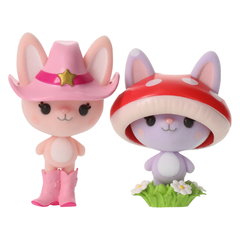Choosing the right material for toys isn’t just a technical decision—it’s a question of safety, quality, and trust. Whether you're a parent shopping for your child or a toy brand planning your next product line, you’ve probably come across PVC. It’s everywhere in the toy world—but is it actually a good material for toys? Is it safe? And how does it stack up against other plastics?
Let’s dive into what toy manufacturers have to say.

What Is PVC in Toy Making?
PVC stands for Polyvinyl Chloride. It’s one of the most widely used plastics in the world. You’ll find it in everything from plumbing pipes to window frames—and yes, toys too.
There are two types of PVC:
- Rigid PVC (used for structural parts)
- Flexible PVC (used for bendable toy parts)
Because it’s so versatile, manufacturers can shape it in many ways and use it for different kinds of toys.
Why Is PVC Used in Toys? Pros and Cons
PVC has become a go-to material in the toy industry—and for good reason. Its unique properties make it ideal for a wide range of toy types, from tiny figurines to large playsets.
First, PVC is incredibly versatile.
It can be easily molded into detailed shapes, which is essential for creating expressive faces, tiny accessories, and complex character designs. This makes it especially popular for action figures, animal toys, dolls, and other collectible figures where detail matters.
Next, it’s known for its durability.
PVC toys can withstand bending, squeezing, and rough handling without breaking—perfect for kids who love to play hard. Some versions of PVC are soft and flexible, while others are firm and sturdy, allowing manufacturers to choose the right feel for each toy.
Another big plus? Cost efficiency.
Compared to other plastics, PVC is relatively affordable, especially when producing toys in large quantities. It helps brands keep production costs down without sacrificing quality.
That’s why many custom PVC toy manufacturers choose it: it strikes a great balance between design flexibility, strength, and price.
Pros of PVC in Toys
- Highly moldable: Great for detailed or custom shapes.
- Durable: Stands up to wear and tear.
- Flexible options: Comes in soft or rigid forms.
- Affordable: Keeps production costs manageable.
- Widely available: Easy to source at scale.
Cons of PVC in Toys
- Not the greenest: Traditional PVC isn’t biodegradable.
- Recycling can be tricky: Not all recycling centers accept it.
- Quality varies: Low-grade PVC may contain harmful chemicals if not properly regulated.
So while PVC is a practical and popular material, its performance depends heavily on the quality of production. Reputable manufacturers, such as Weijun Toys, now use non-toxic, phthalate-free, and BPA-free PVC, making it a much safer choice than in the past.
Let Weijun Toys Be Your Trusted PVC Toy Manufacturer
√ 2 Modern Factories
√ 30 Years of Toy Manufacturing Expertise
√ 200+ Cutting-Edge Machines Plus 3 Well-Equipped Testing Laboratories
√ 560+ Skilled Workers, Engineers, Designers, and Marketing Professionals
√ One-Stop Customization Solutions
√ Quality Assurance: Able to Pass EN71-1,-2,-3 and More Tests
√ Competitive Prices and On-Time Delivery
PVC vs. Other Toy Materials
How does PVC compare to other plastics used in toys?
- PVC vs. ABS: ABS is harder and more rigid, often used for LEGO-style toys. PVC is softer and more flexible.
- PVC vs. PE (Polyethylene): PE is softer but less durable. It’s more common in simple, squeezable toys.
- PVC vs. Silicone: Silicone is safer and more eco-friendly, but it’s also more expensive.
In short, PVC offers a good balance of cost, flexibility, and detail—but it’s not always the best choice depending on the toy type.
To read the more detailed comparison between mainstream plastics, please visit custom plastic toys or plastic material in toys.
Eco-Friendly Considerations
Let’s talk green.
PVC can be recycled, but it’s not as easy as recycling other plastics. Many curbside recycling programs don’t accept it. Still, some toy factories now use recycled PVC to reduce waste.
If sustainability is important to your brand or your purchase, look for:
- Recyclable plastic toys
- Eco-friendly toy materials
- Manufacturers that offer green production options
Final Thoughts
Yes—with the right quality control.
PVC is strong, flexible, and affordable. It works well for making detailed toys like figures and dolls. But safety depends on how it’s made and who makes it. Always choose reputable manufacturers who follow strict safety standards and offer non-toxic PVC.
And if you’re a business looking to create toys? Partner with a custom PVC toy manufacturer that understands both the design and safety side of production.








